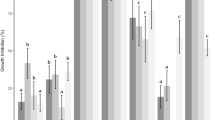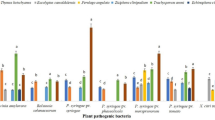Abstract
Fungal pathogens are a growing worldwide concern. Declines in a number of economically and agriculturally important plant and animal species pose a significant threat to both biodiversity and food security. Although many effective antifungal agents have been identified, their toxicity often precludes their use with food products or sensitive animal species. This has prompted the exploration of natural products as effective treatment compounds. In the present study, several essential oils were tested for their capacity to limit the growth of the fungal pathogens Ascosphaera apis and Pseudogymnoascus destructans, the causative agents of chalkbrood disease among honey bee larvae and white-nose syndrome among bats, respectively. Essential oils of cinnamon bark, citronella, lemongrass, and orange were exposed to A. apis in contact-dependent oil-agar suspensions as well as in contact-independent shared airspaces. Essential oils of cinnamon bark, citronella, and lemongrass were exposed to P. destructans in contact-dependent oil-agar suspensions. All compounds were found to significantly inhibit mycelial growth at low concentrations, suggesting the potential for these natural products to be used for controlling these and other select fungal pathogens.





Similar content being viewed by others
References
Aktar W, Senupta D, Chowdhury A. Impact of pesticides use in agriculture: their benefits and hazards. Interdiscip Toxicol. 2009;2:1–12. https://doi.org/10.2478/v10102-009-0001-7.
Aronstein KA, Murray KD. Chalkbrood disease in honey bees. J Invertebr Pathol. 2010;103:S20–9. https://doi.org/10.1016/j.jip.2009.06.018.
Blaylock IT, Richards TH. Honey bees: colony collapse disorder and pollinator role in ecosystems. Hauppauge: Nova Science Publishers; 2009.
Blehert DS, Hicks AC, Behr M, Meteyer CU, Berlowski-Zier BM, Buckles El, Coleman JTH, Darling SR, Gargas A, Niver R, Okoniewski JC, Rudd RJ, Stone WB. Bat white-nose syndrome: an emerging fungal pathogen? Science. 2008;323:227.
Boire N, Zhang S, Khuvis J, Lee R, Rivers J, Crandall P, Keel MK, Parrish N. Potent inhibition of Pseudogymnoascus destructans, the causative agent of white-nose syndrome in bats, by cold-pressed, terpeneless, Valencia orange oil. PLoS ONE. 2016;11:e0148473. https://doi.org/10.1371/journal.pone.0148473.
Boyles JG, Cryan PM, McCracken GF, Kunz TH. Economic importance of bats in agriculture. Science. 2011;332:41–2. https://doi.org/10.1126/science.1201366.
Chen Q, Xu S, Wu T, Guo J, Sha S, Zheng X, Yu T. Effect of citronella essential oil on the inhibition of postharvest Alternaria alternata in cherry tomato. J Sci Food Agric. 2014;94:2441–7. https://doi.org/10.1002/jsfa.6576.
Claussen P. Entwicklungsgeschichtliche Untersuchungen iiber den erreger der Ais “Kalkbrut” bezeichneten Krankheit der Bienen. Arbeiten der Biologischen Reichsanstalt für Land-und Forstwirtschaft. 1921;10:467–521.
Cornelison CT, Gabriel KT, Barlament C, Crow SA Jr. Inhibition of Pseudogymnoascus destructans growth from Conidia and mycelial extension by bacterially produced volatile organic compounds. Mycopathologia. 2014;177:1–10. https://doi.org/10.1007/s11046-013-9716-2.
Cornelison CT, Keel MK, Gabriel KT, Barlament CK, Tucker TA, Pierce GE, Crow SA. A preliminary report on the contact-independent antagonism of Pseudogymnoascus destructans by Rhodococcus rhodochrous strain DAP96253. BMC Microbiol. 2014;14:246. https://doi.org/10.1186/s12866-014-0246-y.
Davis C, Ward W. Control of chalkbrood disease with natural products. Wagga Wagga: Rural Industries Research and Development Corporation; 2003.
Dayan FE, Cantrell CL, Duke SO. Natural products in crop protection. Bioorg Med Chem. 2009;17:4022–34. https://doi.org/10.1016/j.bmc.2009.01.046.
Ecobichon DJ. Pesticide use in developing countries. Toxicology. 2001;160:27–33. https://doi.org/10.1016/S0300-483X(00)00452-2.
Fisher MC, Henk DA, Briggs CJ, Brownstein JS, Madoff LC, McCraw SL, Gurr SJ. Emerging fungal threats to animal, plant and ecosystem health. Nature. 2012;484:186–94. https://doi.org/10.1038/nature10947.
Gabriel KT, Sexton DJ, Cornelison CT. Biomimicry of volatile-based microbial control for managing emerging fungal pathogens. J Appl Microbiol. 2018;124:1024–31. https://doi.org/10.1111/jam.13667.
Hallam TG, Federico P. The Panzootic white-nose syndrome: an environmentally constrained disease? Transbound Emerg Dis. 2012;59:269–78. https://doi.org/10.1111/j.1865-1682.2011.01268.x.
Higley C, Higley A. Reference guide for essential oils. Chandler: Abundant Health; 2013.
Hillier NK, Frost EH, Shutler D. Fate of dermally applied miticides fluvalinate and amitraz within honey bee (Hymenoptera: Apidae) bodies. J Econ Entomol. 2013;106:558–65. https://doi.org/10.1603/EC12300.
Hoyt JR, Cheng TL, Langwig KE, Hee MM, Frick WF, Kilpatrick AM. Bacteria isolated from bats inhibit the growth of Pseudogymnoascus destructans, the causative agent of white-nose syndrome. PLoS ONE. 2015;10:e0121329. https://doi.org/10.1371/journal.pone.0121329.
Huang W-F, Solter LF, Yau PM, Imai BS. Nosema ceranae escapes fumagillin control in honey bees. PLoS Pathog. 2013;9:e1003185. https://doi.org/10.1371/journal.ppat.1003185.
Jeong E, Lee N, Oh J, Jang S, Lee J, Bae I, Oh H, Jung H, Jeong Y. Inhibitory effect of cinnamon essential oils on selected cheese-contaminating fungi (Penicillium spp.) during the cheese-ripening process. Food Sci Biotechnol. 2014;23:1193–8. https://doi.org/10.1007/s10068-014-0163-8.
Katsukawa M, Nakata R, Takizawa Y, Hori K, Takahashi S, Inoue H. Citral, a component of lemongrass oil, acyivates PPARα and γ and suppresses COX-2 expression. Biochim Biophys Acta. 2010;1801:1214–20. https://doi.org/10.1016/j.bbalip.2010.07.004.
Kim Y-G, Lee J-H, Kim S-I, Baek K-H, Lee J. Cinnamon bark oil and its components inhibit biofilm formation and toxin production. Int J Food Microbiol. 2015;195:30–9. https://doi.org/10.1016/j.ijfoodmicro.2014.11.028.
Kim S-I, Lee D-W. Toxicity of basil and orange essential oils and their components against two coleopteran stored products insect pests. J Asia-Pac Entomol. 2014;17:13–7. https://doi.org/10.1016/j.aspen.2013.09.002.
Klein A-M, Vaissiere BE, Cane JH, Steffan-Dewenter I, Cunningham SA, Kremen C, Tscharntke T. Importance of pollinators in changing landscapes for world crops. Proc R Soc B Biol Sci. 2007;274:303–13. https://doi.org/10.1098/rspb.2006.3721.
Koul O, Walia S, Dhaliwal GS. Essential oils as green pesticides: potential and constraints. Biopestic Int. 2008;4:63–84.
Kunz TH, Braun de Torrez E, Bauer D, Tatyana L, Fleming TH. Ecosystem services provided by bats. Ann N Y Acad Sci. 2011;1223:1–38. https://doi.org/10.1111/j.1749-6632.2011.06004.x.
Langwig KE, Frick WF, Bried JT, Hicks AC, Kunz TH, Kilpatrick AM. Sociality, density-dependence and microclimates determine the persistence of populations suffering from a novel fungal disease, white-nose syndrome. Ecol Lett. 2012;15:1050–7. https://doi.org/10.1111/j.1461-0248.2012.01829.x.
Lee JJ. Killer fungus that’s devastating bats may have met its match. In: National geographic. 2015. https://news.nationalgeographic.com/2015/05/150527-bats-white-nose-syndrome-treatment-conservation-animals-science. Accessed 16 May 2018.
Li W-R, Shi Q-S, Ouyang Y-S, Chen Y-B, Duan S-S. Antifungal effects of citronella oil against Aspergillus niger ATCC 16404. Appl Microbiol Biotechnol. 2013;97:7483. https://doi.org/10.1007/s00253-012-4460-y.
Maassen A. Weitere Mitteilungen iiber der Seuchenhaften Brutkankheiten der Bienen. Mitteilungen aus der Kaiserlichen Biologischen Anstalt für Land-und Forstwirtschaft. 1916;14:48–58.
Padilla LR. Emerging fungal diseases of wild animal species. In: Pray L, Relman DA, Choffnes ER, Olsen L, editors. Fungal diseases: an emerging threat to human, animal, and plant health. 1st ed. Washington: National Academies Press; 2011. p. 296–312.
Pergentino de Sousa D. Medicinal essential oils: chemical, pharmacological and therapeutic aspects (botanical research and practices). Hauppauge: Nova Science Publishers; 2012.
Pimentel D, Acquay H, Biltonen M, Rice P, Silva M, Nelson J, Lipner V, Giordano S, Horowitz A, D’Amore M. Environmental and economic costs of pesticide use. Bioscience. 1992;42:750–60. https://doi.org/10.2307/1311994.
Potts SG, Biesmeijer JC, Kremen C, Neumann P, Schweiger O, Kunin WE. Global pollinator declines: trends, impacts and drivers. Trends Ecol Evol. 2010;25:345–53. https://doi.org/10.1016/j.tree.2010.01.007.
Sellamuthu PS, Sivakumar D, Soundy P. Antifungal activity and chemical composition of thyme, peppermint and citronella oils in vapor phase against avocado and peach postharvest pathogens. J Food Saf. 2012;33:86–93. https://doi.org/10.1111/jfs.12026.
Taweechaisupapong S, Ngaonee P, Patsuk P, Pitiphat W, Khunkitti W. Antibiofilm activity and post antifungal effect of lemongrass oil on clinical Candida dubliniensis isolate. S Afr J Bot. 2012;78:37–43. https://doi.org/10.1016/j.sajb.2011.04.003.
Taweechaisupapong S, Aieamsaard J, Chitropas P, Khunkitti W. Inhibitory effect of lemongrass oil and its major constituents on Candida biofilm and germ tube formation. S Afr J Bot. 2012;81:95–102. https://doi.org/10.1016/j.sajb.2012.06.003.
Yoder JA, Jajack AJ, Cornacchione WS, Dunn AL, Cunningham EG, Matchett CL, Rosselot AE. In vitro evaluation of sugar syrups, antibiotics, and miticides on growth of honey bee pathogen, Ascosphaera apis: emphasis for chalkbrood prevention is on keeping bees healthy. Apidologie. 2014;45:568–78. https://doi.org/10.1007/s13592-014-0274-5.
Zukal J, Bandouchova H, Bartonicka T, Berkova H, Brack V, Brichta J, Dolinay M, Jaron KS, Kovacova V, Kovarik M, Martinkova N, Ondracek K, Rehak Z, Turner GG, Pikula J. White-nose syndrome fungus: a generalist pathogen of hibernating bats. PLoS ONE. 2014;2014(9):e97224. https://doi.org/10.1371/journal.pone.0097224.
Zukal J, Berkova H, Madaraszova J. Flying or sleeping: flight activity of bats in natural cave with confirmed WNS. Folia Zool. 2016;65:46–51. https://doi.org/10.25225/fozo.v65.i1.a7.2016.
Acknowledgements
The authors would like to thank Kevin Keel for providing the P. destructans fungal cultures used in this study. The authors would also like to thank Ariel J. Santiago for his support with statistical analyses.
Funding
This study was funded by the Georgia State University Department of Biology.
Author information
Authors and Affiliations
Contributions
LK performed the research, KTG prepared the manuscript, and SAC, Jr. and CTC conceived and designed the study. LK and KTG analyzed the data.
Corresponding author
Ethics declarations
Conflict of interest
The authors declare that they have no conflict of interest.
Additional information
Handling editor: Sudha Chaturvedi.
Rights and permissions
About this article
Cite this article
Gabriel, K.T., Kartforosh, L., Crow, S.A. et al. Antimicrobial Activity of Essential Oils Against the Fungal Pathogens Ascosphaera apis and Pseudogymnoascus destructans. Mycopathologia 183, 921–934 (2018). https://doi.org/10.1007/s11046-018-0298-x
Received:
Accepted:
Published:
Issue Date:
DOI: https://doi.org/10.1007/s11046-018-0298-x




